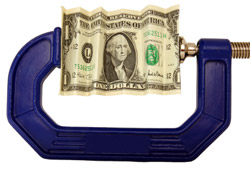Can buying a new car be impacted by greedy home-lending practices the past two years?
Answer: you betcha, this could be one of the biggest stories nationwide
Recent media reports shed light into how lenders and consumers are reacting to the innumerable home foreclosures since late in 2006.
A Nation of Credit
 For example, Automotive News reported that the average length of a new-car loan is 64 months, a considerable bump up from 2003’s 61-month loan average.
For example, Automotive News reported that the average length of a new-car loan is 64 months, a considerable bump up from 2003’s 61-month loan average.
New car sellers are trying to tap into the market of consumers who are “payment driven,†meaning the monthly payment is more important to them than the overall cost of the car.
In light of the sour economy, hindered in large part by the home-financing debacle, buyers are closely watching their personal budgets.
Also interesting, information on Google indicated that American online new-vehicle shoppers dropped by 16% from March 2007 to March 2008, while during the same period 35% more people visited parts and service sites.
Lately, motorists tend to fix what they have rather than gambling on a lengthy new-car investment.
In response, marketing gurus focused on the automotive industry are presenting programs to help dealers better target online buyers.
The Financing Wave of Tomorrow
What’s interesting is why – marketers are targeting car-buyers’ behavior to increase revenues during these hard times.
 Cobalt, a leading provider of marketing services to the retail automotive industry, recently announced new search campaigns for its PowerSearch customers that focus specifically on parts and service.
Cobalt, a leading provider of marketing services to the retail automotive industry, recently announced new search campaigns for its PowerSearch customers that focus specifically on parts and service.
Cobalt wants to help dealers attract more online surfers to their sites, and in effect increase sales – even if it’s just for parts and services.
As an example, let’s examine information from the U.S. Federal Reserve about consumer credit terms, released in June 2008.
No surprise that interest rates for new car loans increased from 4.55% in late 2007 to 5.49% June 2008.
Of note is that the length of those loans – their “maturity†in months – increased from 62.9 to 63.5.
Car buyers, indeed, are not afraid to pay monthly payments longer, as long as the payments were lower.
New Car Financing in a Tough Market
Then there is how much new car buyers are willing to finance.
In the fourth quarter of 2007, new-car buyers were financing an average of $29,512. Six months later, that number was $24,505.
 In fact, in 2008 the average dropped from $27,397 in April 2008 to $24,579 in May, to $24,505 in June.
In fact, in 2008 the average dropped from $27,397 in April 2008 to $24,579 in May, to $24,505 in June.
Figures for July and August 2008 should be interesting. It should be noted that historically the economy stalls during a Presidential election as consumers put off large purchases until they know who will ultimately be in charge.
Perhaps January 2009 will bring sunshine to an otherwise gloomy industry, as the new Commander in Chief generates some confidence.
That might be wishful thinking. The Colorado Springs Business Journal reported in June 2008 that the subprime mortgage crisis has resulted in tighter credit standards for new-car buyers.
A dealership business manager was quoted as saying, “qualifying to buy a car is much more difficult than it was two years ago.”
With nerves rattling about home foreclosures, auto-loan defaults have caught the attention of lenders. Income and spending habits are now very important when trying to finance an auto purchase.
One bank executive noted that defaults on auto loans have increased dramatically for borrowers with credit scores below 720. To cover the risk, interest rates are raised for those without strong credit ratings.
If you are in that boat, expect to get a rate of about 15% for a $15,000, 72-month new-car loan – after kicking in a 10% to 15% down payment.
That rate was 11.9%, with just 5% down for the same loan in 2006.
